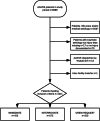Helicopter emergency medical service dispatch in older trauma: time to reconsider the trigger?
- PMID: 33962682
- PMCID: PMC8103626
- DOI: 10.1186/s13049-021-00877-3
Helicopter emergency medical service dispatch in older trauma: time to reconsider the trigger?
Abstract
Background: Helicopter Emergency Medical Services (HEMS) respond to serious trauma and medical emergencies. Geographical disparity and the regionalisation of trauma systems can complicate accurate HEMS dispatch. We sought to evaluate HEMS dispatch sensitivity in older trauma patients by analysing critical care interventions and conveyance in a well-established trauma system.
Methods: All trauma patients aged ≥65 years that were attended by the Air Ambulance Kent Surrey Sussex over a 6-year period from 1 July 2013 to 30 June 2019 were included. Patient characteristics, critical care interventions and hospital disposition were stratified by dispatch type (immediate, interrogate and crew request).
Results: 1321 trauma patients aged ≥65 were included. Median age was 75 years [IQR 69-89]. HEMS dispatch was by immediate (32.0%), interrogation (43.5%) and at the request of ambulance clinicians (24.5%). Older age was associated with a longer dispatch interval and was significantly longer in the crew request category (37 min [34-39]) compared to immediate dispatch (6 min [5-6] (p = .001). Dispatch by crew request was common in patients with falls < 2 m, whereas pedestrian road traffic collisions and falls > 2 m more often resulted in immediate dispatch (p = .001). Immediate dispatch to isolated head injured patients often resulted in pre-hospital emergency anaesthesia (PHEA) (39%). However, over a third of head injured patients attended after dispatch by crew request received PHEA (36%) and a large proportion were triaged to major trauma centres (69%).
Conclusions: Many patients who do not fulfil the criteria for immediate HEMS dispatch need advanced clinical interventions and subsequent tertiary level care at a major trauma centre. Further studies should evaluate if HEMS activation criteria, nuanced by age-dependant triggers for mechanism and physiological parameters, optimise dispatch sensitivity and HEMS utilisation.
Keywords: Critical care interventions; Dispatch sensitivity; Helicopter emergency medical service; Older trauma.
Conflict of interest statement
JG, ETA, RDC, MN and RL are all employees of Air Ambulance Kent, Surrey and Sussex. JB, JW and MN are employees of South East Coast Ambulance Service NHS Foundation Trust. There were no financial or non-financial conflicts of interest.
Figures
Similar articles
-
A novel method of non-clinical dispatch is associated with a higher rate of critical Helicopter Emergency Medical Service intervention.Scand J Trauma Resusc Emerg Med. 2018 Sep 25;26(1):84. doi: 10.1186/s13049-018-0551-9. Scand J Trauma Resusc Emerg Med. 2018. PMID: 30253795 Free PMC article.
-
Dispatch of a helicopter emergency medicine service to patients with a sudden, unexplained loss of consciousness of medical origin.BMC Emerg Med. 2020 Nov 25;20(1):92. doi: 10.1186/s12873-020-00388-x. BMC Emerg Med. 2020. PMID: 33238877 Free PMC article.
-
Characteristics of helicopter emergency medical services (HEMS) dispatch cancellations during a six-year period in a Dutch HEMS region.BMC Emerg Med. 2021 Apr 16;21(1):50. doi: 10.1186/s12873-021-00439-x. BMC Emerg Med. 2021. PMID: 33863280 Free PMC article.
-
Trauma-related dispatch criteria for Helicopter Emergency Medical Services in Europe.Injury. 2011 May;42(5):525-33. doi: 10.1016/j.injury.2010.03.015. Epub 2010 Apr 9. Injury. 2011. PMID: 20381803 Review.
-
The cost-effectiveness of physician staffed Helicopter Emergency Medical Service (HEMS) transport to a major trauma centre in NSW, Australia.Injury. 2012 Nov;43(11):1843-9. doi: 10.1016/j.injury.2012.07.184. Epub 2012 Aug 13. Injury. 2012. PMID: 22898559 Review.
Cited by
-
Ambulance service recognition of health inequalities and activities for reduction: An evidence and gap map of the published literature.Br Paramed J. 2024 Jun 1;9(1):47-57. doi: 10.29045/14784726.2024.6.9.1.47. Br Paramed J. 2024. PMID: 38946737 Free PMC article.
-
Nine golden codes: improving the accuracy of Helicopter Emergency Medical Services (HEMS) dispatch-a retrospective, multi-organisational study in the East of England.Scand J Trauma Resusc Emerg Med. 2023 Jun 12;31(1):27. doi: 10.1186/s13049-023-01094-w. Scand J Trauma Resusc Emerg Med. 2023. PMID: 37308937 Free PMC article.
-
Visualized analysis of research on helicopter emergency medical service.Medicine (Baltimore). 2022 Sep 9;101(36):e30463. doi: 10.1097/MD.0000000000030463. Medicine (Baltimore). 2022. PMID: 36086760 Free PMC article.
-
Prehospital critical care dispatch: a scoping review (PHASE).Scand J Trauma Resusc Emerg Med. 2025 Aug 14;33(1):140. doi: 10.1186/s13049-025-01450-y. Scand J Trauma Resusc Emerg Med. 2025. PMID: 40814122 Free PMC article. Review.
-
Prehospital interventions and outcomes in traumatic cardiac arrest: a population-based cohort study using the Danish Helicopter Emergency Medical Services data.Eur J Emerg Med. 2024 Oct 1;31(5):324-331. doi: 10.1097/MEJ.0000000000001108. Epub 2024 Dec 13. Eur J Emerg Med. 2024. PMID: 38100645 Free PMC article.
References
-
- Trauma Audit and Research Network - Major Trauma in Older People - 2017 Report. 2018 [cited 2018 Feb 15]. Available from: https://www.tarn.ac.uk/Content.aspx?c=3793.
-
- Hendrickson SA, Osei-Kuffour D, Aylwin C, Fertleman M, Hettiaratchy S. ‘Silver’ trauma: predicting mortality in elderly major trauma based on place of injury. Scand J Trauma Resusc Emerg Med. 2015;23(2):A4. doi: 10.1186/1757-7241-23-S2-A4. - DOI
Publication types
MeSH terms
LinkOut - more resources
Full Text Sources
Other Literature Sources
Medical



